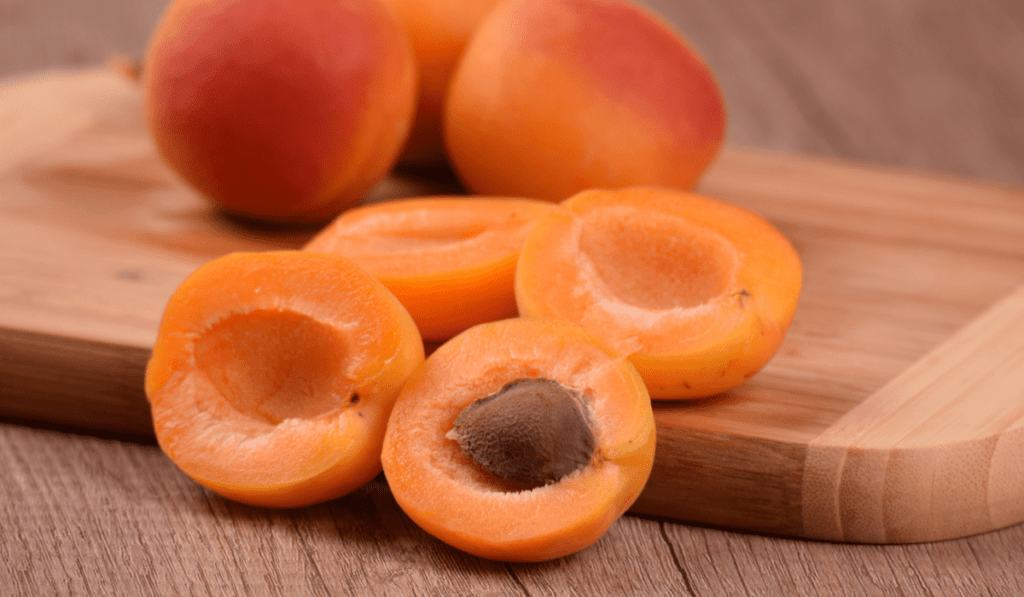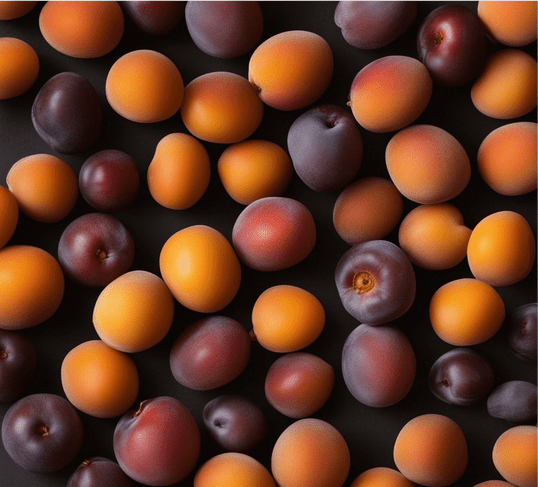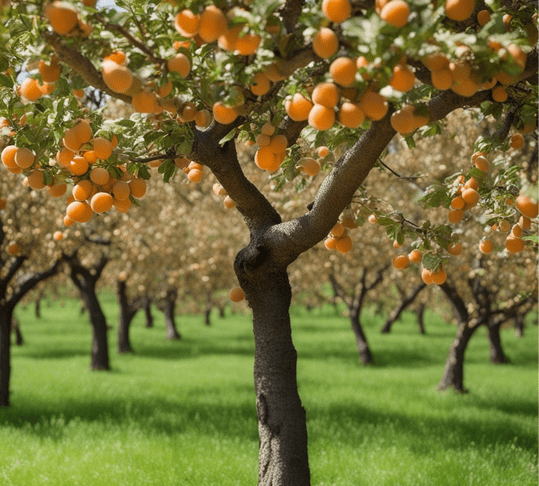Delving into the delectable world of apricots, one quickly realizes that these succulent fruits come in a diverse array of flavors and characteristics. In this tantalizing guide, we invite you to explore the ten most popular apricot varieties, each with its unique taste, texture, and suitability for different culinary uses. Whether you’re a fruit enthusiast, a home gardener, or simply looking to enhance your knowledge of this beloved stone fruit, this journey through apricot varieties promises to broaden your palate and inspire your culinary endeavors. Join us as we embark on a flavorful exploration of the world’s most sought-after apricot cultivars.
10 Most Popular Apricot Varieties
1. Moorpark Apricot (Prunus armeniaca ‘Moorpark’)
- Fruit Description: The Moorpark apricot is renowned for its medium-sized fruit with golden-yellow skin and a rich, aromatic, and sweet orange flesh. It’s incredibly flavorful and perfect for fresh eating or making delicious jams and preserves.
- Growing Zone: Suitable for USDA zones 4-9, making it adaptable to a wide range of climates.
- Taste: Known for its exceptional sweetness and fruity aroma, Moorpark apricots are a favorite among apricot enthusiasts.
- Climate: Thrives in regions with warm summers and cold winters, making it a versatile choice for various climates.
- Why to Choose: Choose Moorpark for its unbeatable flavor, adaptability to diverse climates, and its historical significance as one of the oldest apricot varieties.
2. Harglow Apricot (Prunus armeniaca ‘Harglow’)
- Fruit Description: Harglow apricots are prized for their large, firm fruit with a beautiful golden skin adorned with a red blush. The flesh is sweet-tart and exceptionally juicy.
- Growing Zone: Thrives in USDA zones 5-8, making it suitable for areas with mild winters.
- Taste: The sweet-tart flavor and juicy texture of Harglow apricots make them a delectable choice for fresh consumption or canning.
- Climate: Prefers moderate climates with not too harsh winters, making it an excellent choice for regions with mild winters.
- Why to Choose: Opt for Harglow for its large, juicy fruit, attractive appearance, and versatility for fresh eating or preserving.
3. Goldcot Apricot (Prunus armeniaca ‘Goldcot’)
- Fruit Description: Goldcot apricots produce medium-sized, golden-orange fruit with a sweet and juicy flesh. They are known for their delightful taste.
- Growing Zone: Suited for USDA zones 5-8, making it perfect for regions with mild winters.
- Taste: Goldcot apricots are celebrated for their sweet, succulent flavor, making them a wonderful choice for fresh consumption and cooking.
- Climate: Prefers temperate climates with not too harsh winters, ideal for areas with moderate winters.
- Why to Choose: Choose Goldcot for its deliciously sweet fruit, adaptability to regions with milder winters, and versatility in the kitchen.
4. Tilton Apricot (Prunus armeniaca ‘Tilton’)
- Fruit Description: Tilton apricots offer medium-sized fruit with a vibrant orange skin and sweet, flavorful flesh.
- Growing Zone: Suited for USDA zones 5-8, making it a great choice for regions with mild winters.
- Taste: Tilton apricots are known for their rich sweetness, making them ideal for fresh eating, drying, or canning.
- Climate: Thrives in areas with temperate climates and mild winters.
- Why to Choose: Opt for Tilton for its sweet, flavorful fruit, adaptability to regions with mild winters, and versatility in culinary applications.
5. Tomcot Apricot (Prunus armeniaca ‘Tomcot’)
- Fruit Description: Tomcot apricots produce medium-sized fruit with a reddish-orange skin and a sweet-tangy flavor. The flesh is firm and juicy.
- Growing Zone: Thrives in USDA zones 5-9, making it suitable for a wide range of climates.
- Taste: Tomcot apricots are loved for their sweet and tangy taste, making them perfect for fresh eating and preserving.
- Climate: Adaptable to both colder and warmer climates, making it a versatile choice.
- Why to Choose: Choose Tomcot for its balanced sweet-tangy flavor, adaptability to various climates, and versatility in culinary applications.
6. Perfection Apricot (Prunus armeniaca ‘Perfection’)
- Fruit Description: Perfection apricots are known for their medium-sized, golden fruit with a red blush and sweet, juicy flesh.
- Growing Zone: Suited for USDA zones 4-8, making it suitable for regions with cold winters.
- Taste: These apricots live up to their name with their sweet, juicy, and flavorful flesh, perfect for fresh eating and preserving.
- Climate: Thrives in regions with cold winters, making it an excellent choice for colder climates.
- Why to Choose: Opt for Perfection for its sweet, juicy fruit, adaptability to colder regions, and versatility in the kitchen.
7. Harlayne Apricot (Prunus armeniaca ‘Harlayne’)
- Fruit Description: Harlayne apricots offer large, flavorful fruit with an orange-red skin and sweet, juicy flesh.
- Growing Zone: Suited for USDA zones 4-8, making it suitable for regions with cold winters.
- Taste: Harlayne apricots are prized for their sweet and juicy taste, making them perfect for fresh consumption and processing.
- Climate: Thrives in regions with cold winters, making it an excellent choice for colder climates.
- Why to Choose: Choose Harlayne for its large, juicy fruit, adaptability to colder regions, and versatility in culinary applications.
8. Riland Apricot (Prunus armeniaca ‘Riland’)
- Fruit Description: Riland apricots produce medium-sized fruit with a sweet and slightly tart flavor. They have an attractive orange skin and firm flesh, making them versatile for various culinary uses.
- Growing Zone: Suited for USDA zones 5-9, making it adaptable to a wide range of climates.
- Taste: Known for their sweet and slightly tart flavor, Riland apricots are versatile and suitable for fresh consumption and cooking.
- Climate: Adaptable to various climates, making it a versatile choice.
- Why to Choose: Opt for Riland for its balanced sweet-tart flavor, adaptability to different climates, and versatility in the kitchen.
9. Autumn Glo Apricot (Prunus armeniaca ‘Autumn Glo’)
- Fruit Description: Autumn Glo apricots are medium-sized with an orange skin and sweet, juicy flesh. They are known for their vibrant color and excellent flavor.
- Growing Zone: Suited for USDA zones 5-9, making it adaptable to a wide range of climates.
- Taste: These apricots are celebrated for their sweet, juicy flavor, perfect for fresh eating and preserving.
- Climate: Adaptable to various climates, making it a versatile choice.
- Why to Choose: Choose Autumn Glo for its sweet, juicy fruit, adaptability to different climates, and attractive appearance.
These apricot varieties offer a range of flavors and are suitable for different climates, allowing you to select the one that best suits your preferences and growing conditions. Whether you enjoy them fresh, dried, or in culinary creations, these apricots have something special to offer.
In Conclusion
Apricot trees offer a delightful array of varieties, each with its own unique characteristics, flavors, and adaptability to different climates. Whether you’re an avid gardener or simply an apricot enthusiast, you can select from a diverse range of options to suit your taste preferences and local conditions. Whether you prefer to enjoy apricots fresh off the tree, dried as a nutritious snack, or incorporated into a wide range of culinary creations, these varieties offer endless possibilities. So, go ahead and plant the apricot tree that appeals to you the most, and savor the rewards of nature’s sweet and tangy bounty in your own backyard. Happy apricot gardening!



